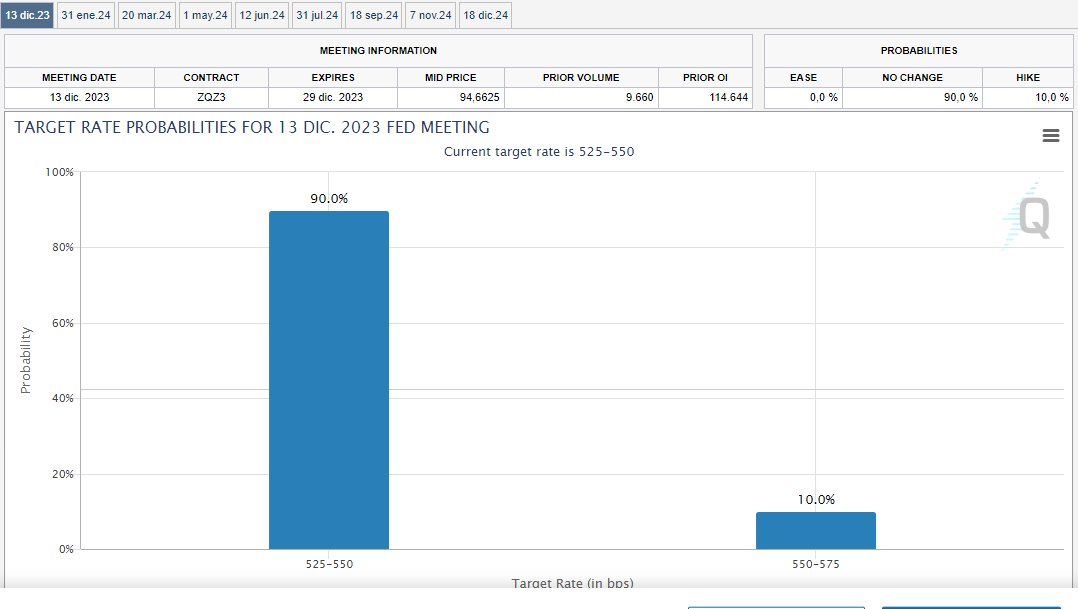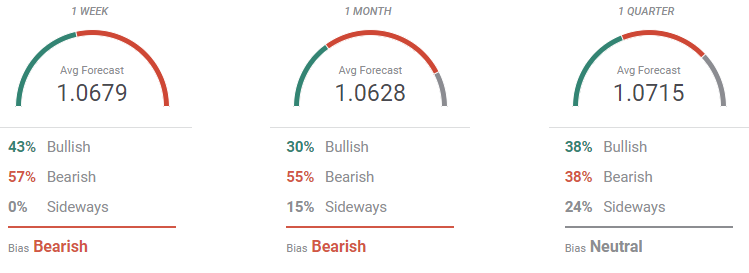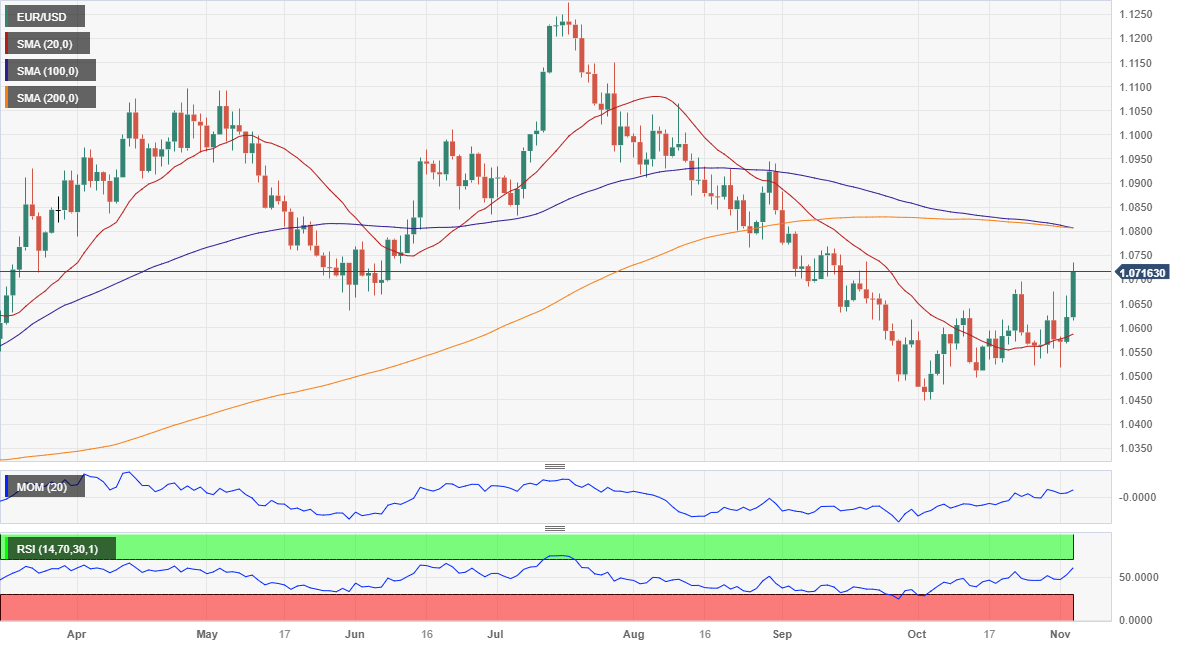- The Federal Reserve kept rates on hold for a second consecutive meeting.
- The Euro Zone economic downturn accelerated at the beginning of Q4.
- EUR/USD broke the upper end of its latest range, skewing risk to the upside.
The EUR/USD pair struggled for direction throughout the week, unimpressed by growth-related figures and central banks’ announcements. The pair finally found directional strength on Friday, following the United States (US) Nonfarm Payroll report, and reconquered the 1.0700 threshold.
The end of monetary tightening?
One thing became evident after this week's developments. Central banks worldwide are done with monetary tightening, as slowing growth is now more of a burden than inflation. True, price pressures remain unevenly elevated but far below the records posted mid-2022.
Nevertheless, after the European Central Bank (ECB) held fire in its latest meeting, it was the turn of the Federal Reserve (Fed) and the Bank of England (BoE) to maintain benchmark rates on hold. Central banks also have in common the notion of “higher for longer,” that is, keeping the monetary policy sufficiently restrictive for long enough to achieve their inflation goals. Policymakers also coincide in indicating that the risks to inflation remain elevated and that they would act accordingly if required.
However, investors did not wholly buy their words and traded optimistically, benefiting high-yielding assets. What central bank authorities are doing right now is cooling speculation for potential rate cuts. Trimming interest rates usually boost the economy but also prices, and with inflation still above central banks’ targets, it is something they can not afford.
Federal Reserve skips commitment
Back to the Fed, the US central bank decided to leave the policy rate unchanged at the range of 5.25%-5.50% for a second consecutive meeting, as widely anticipated. Chairman Jerome Powell was more cautious than usual with his wording throughout the subsequent press conference but brought nothing new to the table.
On the one hand, Powell acknowledged that financial conditions have tightened significantly and that the economy expanded more than expected. However, he also remarked that the labor market remains tight and that policymakers will remain attentive to data showing the economy's resilience and demand for labor. The US Dollar seesawed with the announcement to finally weaken against major rivals.
European downturn accelerates
The Euro had a hard time taking advantage of the broad USD weakness. S&P Global released the final versions of the October Manufacturing PMIs on Thursday, with the report confirming a substantial slump in the manufacturing sector at the beginning of the fourth quarter. The German index was upwardly revised from the preliminary estimate of 40.7 to 40.8, while the final Euro Zone figure was confirmed at 43.1 from the 43.0 initially estimated.
Also, the German economy contracted in the three months to September, as the preliminary estimate of the quarterly Gross Domestic Product (GDP) printed at -0.1% QoQ, slightly better than expected but still in negative ground. The Euro Zone preliminary Q3 GDP also printed at -0.1% QoQ while posting a modest 0.1% uptick from the same quarter of 2022.
On a positive note, the German Harmonized Index of Consumer Prices (HICP) rate was 3.0% YoY in October and, according to preliminary estimates, easing sharply from the previous 4.3%. The Euro Zone Core HICP inflation was confirmed at 4.2% in the same period.
Nonfarm Payrolls shed light
Finally on Friday, the US added 150K new jobs in October, according to the Nonfarm Payrolls (NFP) report, below the 180K expected. The Unemployment Rate increased to 3.9% in the month, higher than the 3.8% forecast, while the Labor Force Participation Rate ticked lower to 62.7% from 62.8% in September. The US Dollar plunged with the news, as the softer-than-anticipated figures weighed on rate hike odds, which were already down following the Fed’s monetary policy decision.
According to the CME Fed WatchTool, the odds for a Fed hike in December fell to 10% from 27% before the central bank’s announcement. The chances of a January hike also decreased.

What’s next?
The upcoming week will be a bit more busy in the Euro Zone than in the United States, but there won’t be many first-tier events. Germany will publish September Factory Orders and Industrial Production and the final estimate of the October HICP.
The EU will unveil November Sentix Investor Confidence, the September Producer Price Index (PPI) and Retail Sales for the same month. Finally, S&P Global will release the final estimates of the Services PMIs.
The US will only offer the preliminary estimate of the November Michigan Consumer Sentiment Index next Friday.
As long as there are no new risk-off factors, the US Dollar will likely remain under selling pressure throughout the upcoming week. Financial markets are far more optimistic, as no more monetary tightening would help economies dodge a steep recession. Most eyes will remain on European developments, as the downturn there has yet to see a bottom. Regardless of the broad weakness of the US Dollar, the Euro may be a lagger among high-yielding assets.

EUR/USD technical outlook
EUR/USD held in the 1.0500/0700 region for the fourth straight week, now just above the upper end of the range, changing hands at around 1.0710. The weekly chart shows that the pair is crossing above its 100 Simple Moving Average (SMA) for the first time since mid-August. Still, moving averages maintain their bearish slopes, with the 20 SMA providing dynamic resistance at around 1.0800. At the same time, technical indicators show upward strength, although still within negative levels. Overall, an interim bottom and a bullish continuation remain unclear in the long term.
However, technical readings in the daily chart favor a bullish continuation. EUR/USD strengthened above a now mildly bullish 20 SMA, while the 100 and 200 SMAs converge at around 1.0810, reinforcing the resistance area. Finally, the Momentum indicator maintains the upward pressure, while the Relative Strength Index (RSI) indicator heads firmly north within positive levels, all of which support an extension towards the 1.0800 mark.
The 1.0640 area provides immediate support ahead of the 1.0520 price zone. On the flip side, beyond 1.0740, a test of the 1.0800 mark will be on the cards, while a break above the latter will confirm a mid-term bullish extension.
EUR/USD sentiment poll
According to the FXStreet Forecast Poll, EUR/USD will remain bearish in the near term, although the late bullish breakout suggests otherwise, catching analysts off guard. Bears are still a majority in the weekly and monthly views, while the number of sellers has decreased. In the quarterly perspective, bulls and bears converge at 38%, with the pair seen holding above the 1.0700 mark on average.
The Overview chart, however, tells a different story. The weekly and monthly moving averages aim north, recovering their positive momentum and suggesting the recovery could continue. Finally, the three-month moving average remains flat amid a quite even spread of potential targets between 1.0300 and 1.1200.

Information on these pages contains forward-looking statements that involve risks and uncertainties. Markets and instruments profiled on this page are for informational purposes only and should not in any way come across as a recommendation to buy or sell in these assets. You should do your own thorough research before making any investment decisions. FXStreet does not in any way guarantee that this information is free from mistakes, errors, or material misstatements. It also does not guarantee that this information is of a timely nature. Investing in Open Markets involves a great deal of risk, including the loss of all or a portion of your investment, as well as emotional distress. All risks, losses and costs associated with investing, including total loss of principal, are your responsibility. The views and opinions expressed in this article are those of the authors and do not necessarily reflect the official policy or position of FXStreet nor its advertisers. The author will not be held responsible for information that is found at the end of links posted on this page.
If not otherwise explicitly mentioned in the body of the article, at the time of writing, the author has no position in any stock mentioned in this article and no business relationship with any company mentioned. The author has not received compensation for writing this article, other than from FXStreet.
FXStreet and the author do not provide personalized recommendations. The author makes no representations as to the accuracy, completeness, or suitability of this information. FXStreet and the author will not be liable for any errors, omissions or any losses, injuries or damages arising from this information and its display or use. Errors and omissions excepted.
The author and FXStreet are not registered investment advisors and nothing in this article is intended to be investment advice.
Recommended Content
Editors’ Picks

Gold falls amid a possible de-escalation of US-China tensions Premium
Gold pulled back from its all-time high of $3,500 per troy ounce reached earlier on Tuesday, as a resurgent US Dollar and signs of easing tensions in the US–China trade dispute appeared to draw sellers back into the market.

EUR/USD retreats to daily lows near 1.1440
EUR/USD loses the grip and retreats to the 1.1440 zone as the Greenback’s rebound now gathers extra steam, particulalry after some positive headlines pointing to mitigating trade concerns on the US-China front on Tuesday.

GBP/USD deflates to weekly lows near 1.3350
GBP/USD loses further momentum and recedes to the 1.3350 zone on Tuesday, or two-day troughs, all in response to the frmer tone in the US Dollar and encouraging news from the US-China trade scenario.

3% of Bitcoin supply in control of firms with BTC on balance sheets: The good, bad and ugly
Bitcoin disappointed traders with lackluster performance in 2025, hitting the $100,000 milestone and consolidating under the milestone thereafter. Bitcoin rallied past $88,000 early on Monday, the dominant token eyes the $90,000 level.

Five fundamentals for the week: Traders confront the trade war, important surveys, key Fed speech Premium
Will the US strike a trade deal with Japan? That would be positive progress. However, recent developments are not that positive, and there's only one certainty: headlines will dominate markets. Fresh US economic data is also of interest.

The Best brokers to trade EUR/USD
SPONSORED Discover the top brokers for trading EUR/USD in 2025. Our list features brokers with competitive spreads, fast execution, and powerful platforms. Whether you're a beginner or an expert, find the right partner to navigate the dynamic Forex market.
